Please Note: Firefox
and some other search engines are not suitable – Use “Internet Explorer” for this page to load perfectly!
Click the logo above to
reach the ssMaritime FrontPage for News Updates & “Ship of the
Month”
With Reuben
Goossens
Maritime
Historian, Cruise‘n’Ship Reviewer & Author

Page One
Please Note: Page One will cover this
fine Canadian Pacific liner, the RMS Empress of England, whilst Pages
Two and Three will cover her last five years as the Shaw Savill liner and
cruise ship, the SS Ocean Monarch!
Introduction:
The Canadian Pacific
Line had already built the elegant and sleek looking RMS Empress of

The Empress seen
on the stocks at Vickers-Armstrong, but ready to be launched
She was launched
by Lady Eden, the wife of the Prime Minister, the Hon, Mr. Anthony Eden on May
9, 1956. Then speaking after the launch, Lady Eden said: “This must be a
day of satisfaction for Canadian Pacific. War brought the almost complete
annihilation of the Empress class of ships, and I believe it is true that no
other line suffered as heavily as yours. We in
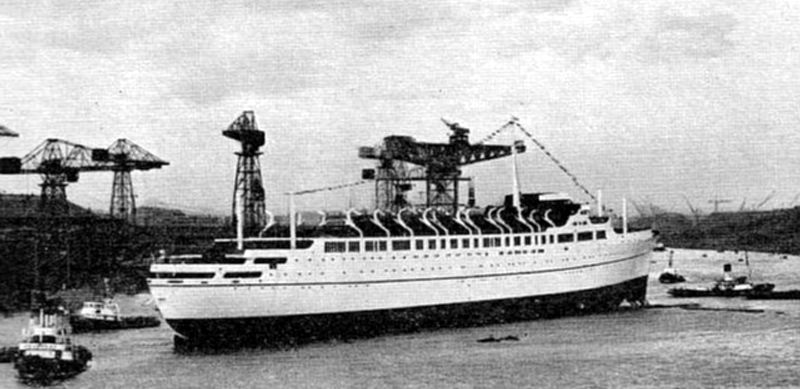
Here we see the
newly launched ship on her way to the fit-out berth
The gleaming white RMS Empress of
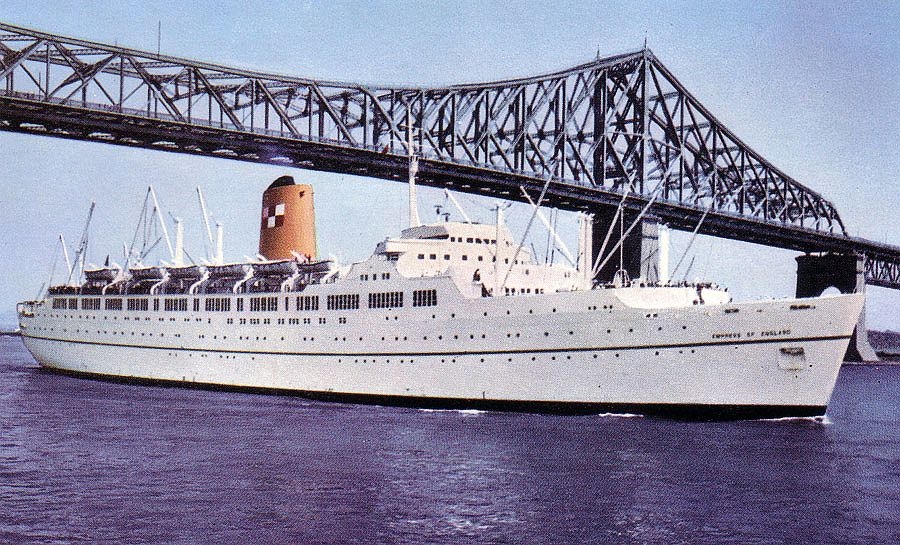
Her maiden
arrival to

Above &
below: The cover and the introduction page to the passenger list of the
Maiden Voyage
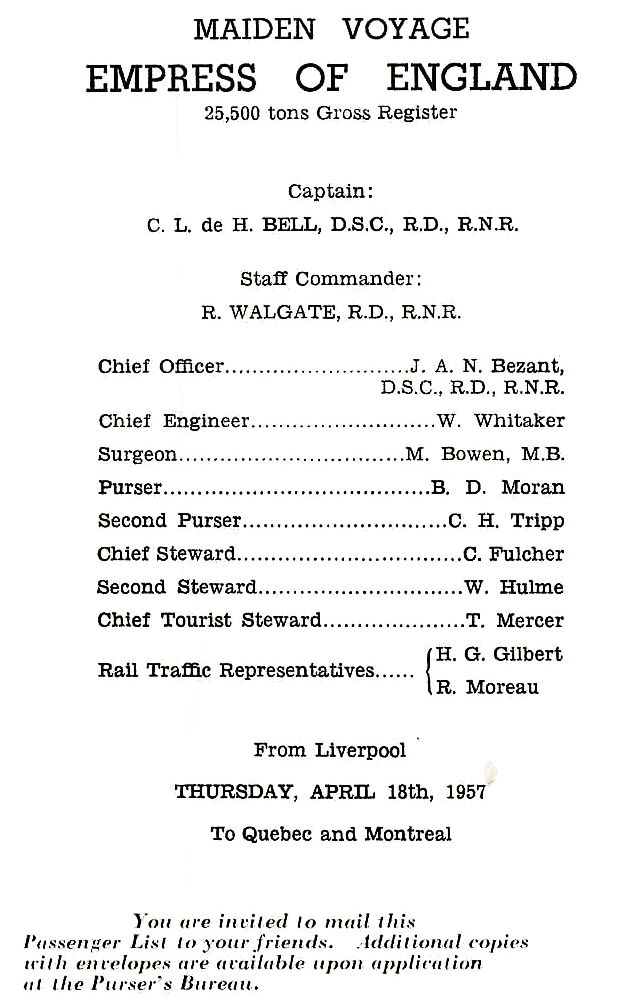
A Note regarding
differences between these two sister ships:
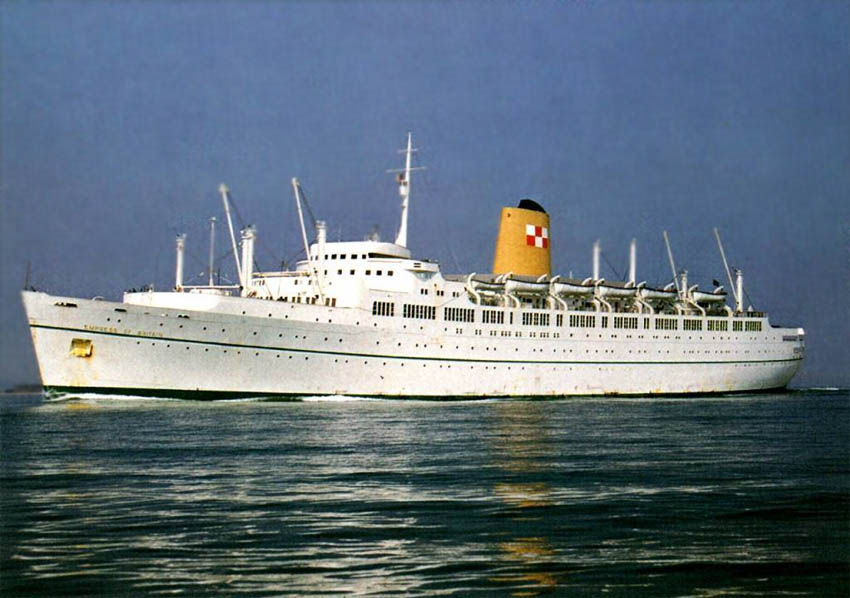
RMS Empress of
Although her earlier sister looked practically identical, it was still relatively easy to separate the two ships from each other, for looking at Boat Deck forward and both the Empress of Britain and England had windows located there just below the Bridge. The Empress of Britain had them arranged as follows, 2 + 2 + 2, whereas on the Empress of England they were spaced 2 + 1 + 2.
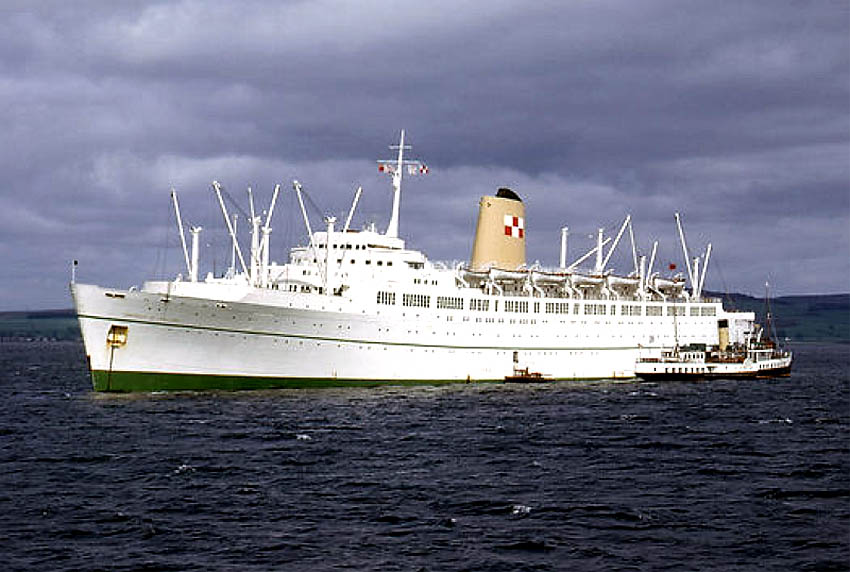
RMS Empress of
Empress of Canada, the third ship and much newer ship was built in 1960 the 27,284 ton RMS Empress of Canada was launched and she commenced her maiden voyage to Canada fro Liverpool on April 24, 1961. However, she was far a more modern and distinct looking liner, having a distinctive top to her funnel as well as a more built up superstructure, especially the forward section being more pronounced and bulky.

The RMS Empress
of
Empress of
England
Like her sister the Empress of Britain, for a ship of her size she had rather a long and a very low profile. The majority of her public rooms were arranged on the Promenade Deck, First Class lounges were located forward and Tourist Class aft. The venue located furthermost aft being the Cinema which was shared by both classes. Up on Boat Deck located forward directly under the Bridge, was another of the First Class Lounges, that had large windows along the aft wall over looking a sheltered Sun Deck.
First Class Photographs
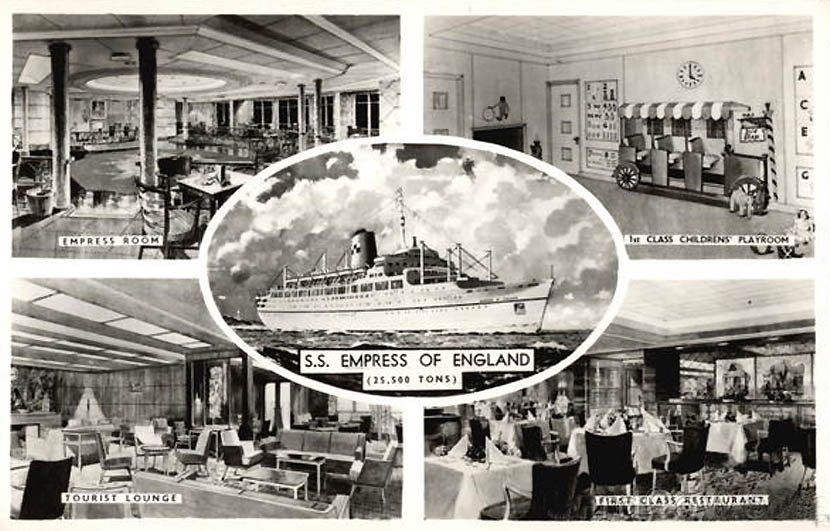
An early
postcard released by Canadian Pacific

One of the
Lounges
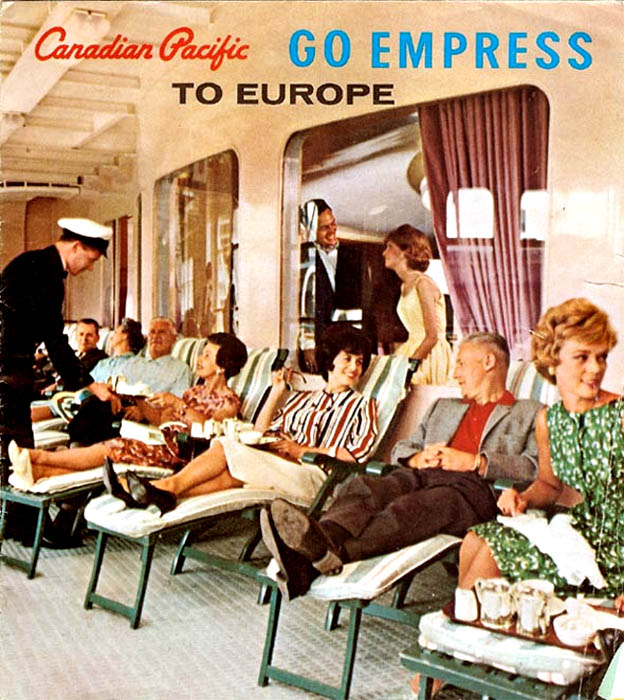
Luxuriating on
Promenade Deck with a good hot drink
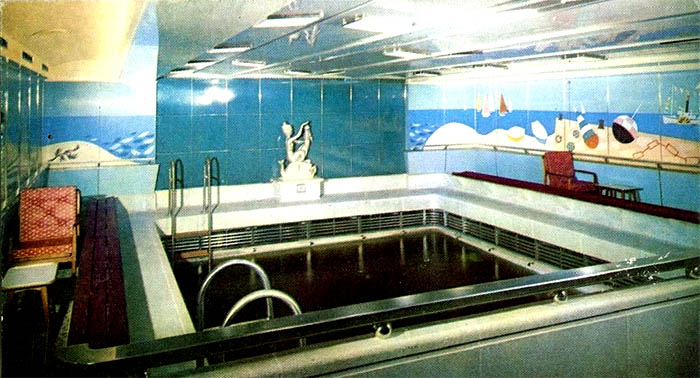
Above &
below: It is fun in the Indoor Pool
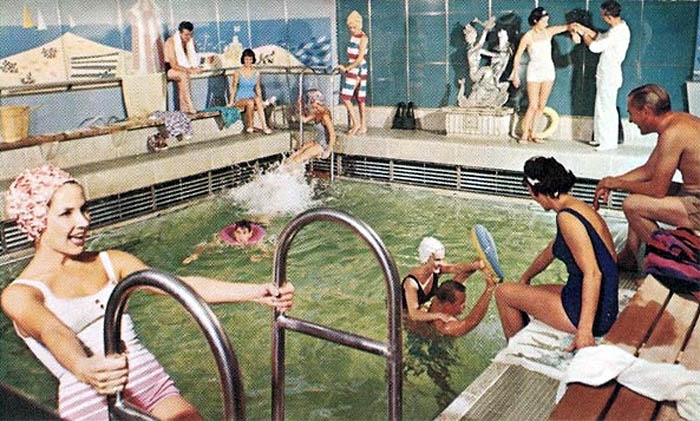
Tourist Class Photographs
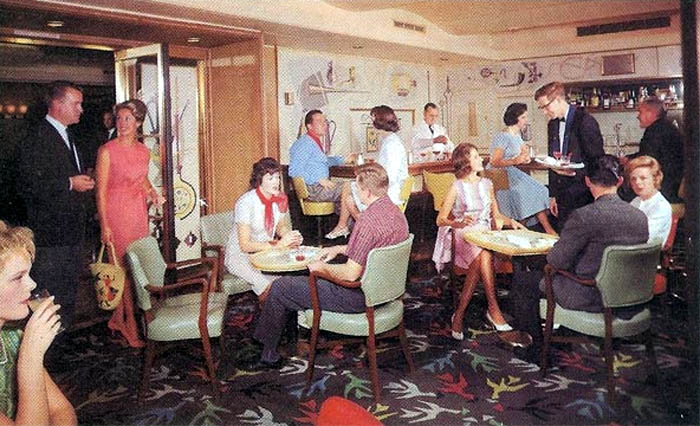
A delightful
Cocktail Lounge

The Dining Room
Below Promenade Deck there were three decks mostly for accommodations, these where A, B and C Decks.
A Deck was devoted to First Class, and B to Tourist Class. Whilst C Deck had Tourist accommodations located aft, but forward was the First and Tourist Class (aft) Restaurants with the galleys located between them. A Deck also had the First Class Main Entrance and the Pursers Office. Whilst the second Class Entrance was aft on B Deck.
Accommodations:
First Class offered some fine suites and semi
suites. These luxury accommodations included 2 or 3 rooms, private facilities
with full bath and/or shower and some even had an enclosed veranda. Other First
Class cabins were either one or twin bedded with all having private facilities.
All Tourist Class cabins were two berth cabins with many had upper
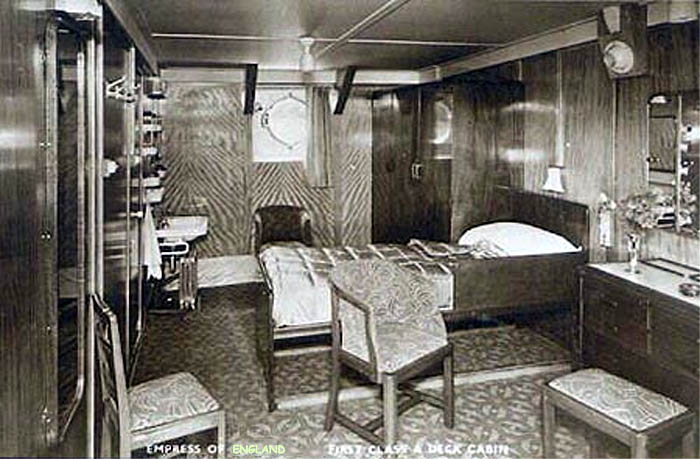
A First Class
outside single cabin
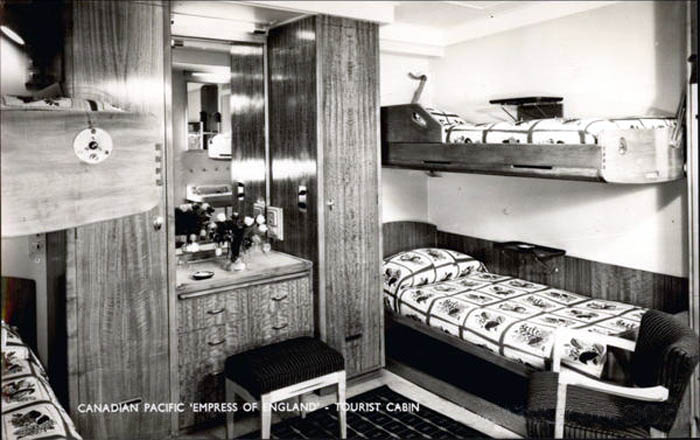
A typical
Tourist Class four berth outside cabin, the porthole
is just out of
view on the right
Cargo:
She had six cargo holds with 380,650 cu, ft of space, of which 80,000 cu, ft was refrigerated in hold number 5. Number 2 hold was also designed to take cars. For loading purposes, she had four all white and slender kingposts forward and four aft and these did not distract from her overall look!
Livery:
The ship had that typical Canadian Pacific livery featuring a stylish buff funnel with the red and white chequered house flag! Her hull and superstructure being all white with a green ribbon wrapped around her hull with green boot topping. Unusually set far aft atop of her bridge she had her tall but nicely stylised slender mast, but still with the traditional crow’s nest two thirds of the way up. She was a well balanced looking liner with her pleasant CP livery. However, in 1968 her livery would change dramatically as I will reveal later!
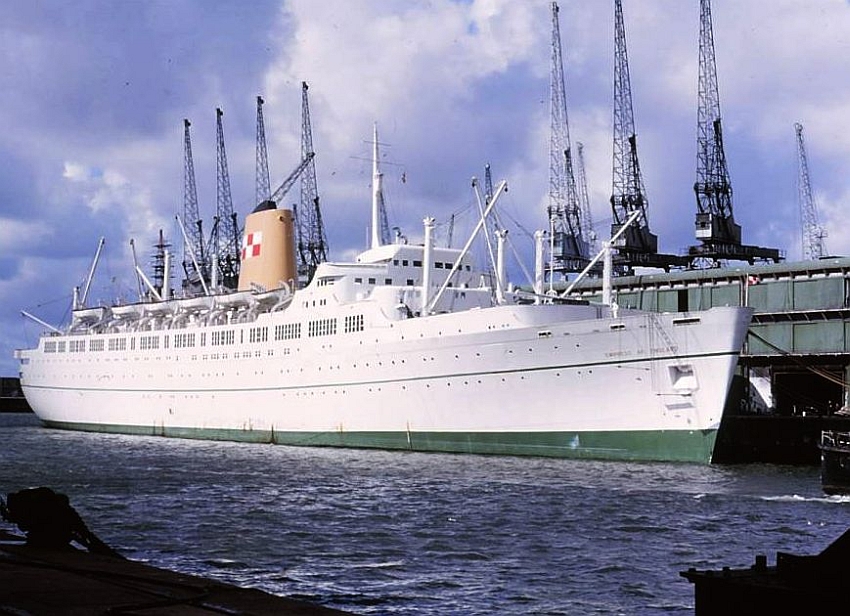
The Empress is
seen here at
RMS Empress of
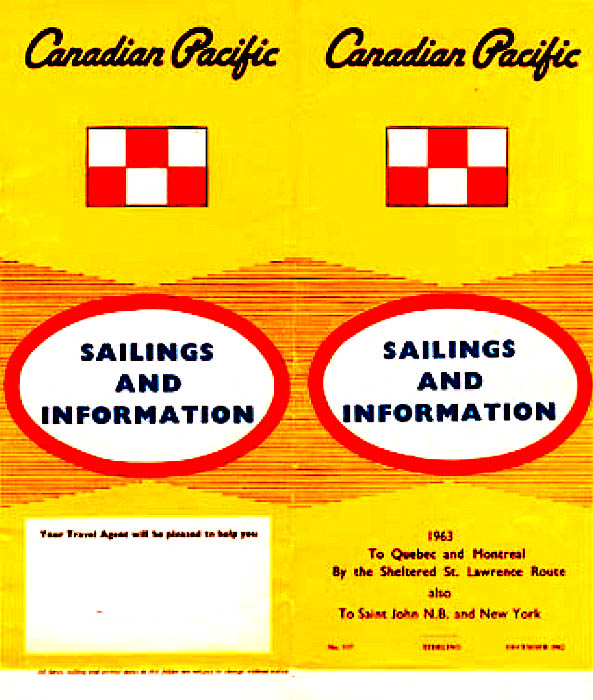
After this Trans
Atlantic Schedule she would commence fulltime cruise operations
It would be in 1963 that there was an
acceleration rapid decline of the loading onboard all ships crossing the
“Travel Savings Association” (TSA)
arrived on the scene just in time for CP in 1963, and Canadian Pacific was only
too happy to charter the Empress of England and the Empress of Britain to
operate TSA cruises, and to acquire a 51 per cent interest in the business. On
November 28, 1963 the Empress of England sailed for
Sadly, the TSA bubble burst and by April 1964
both the Empress of England and the Empress of Canada were back on the St
Lawrence run. At the conclusion of the TSA cruises, it had been decided in 1964
to sell the oldest of the trio, Empress of Britain and she was quickly was sold
to the Greek Line to become the SS Queen Anna Maria. Now operating with two
ships operating on the
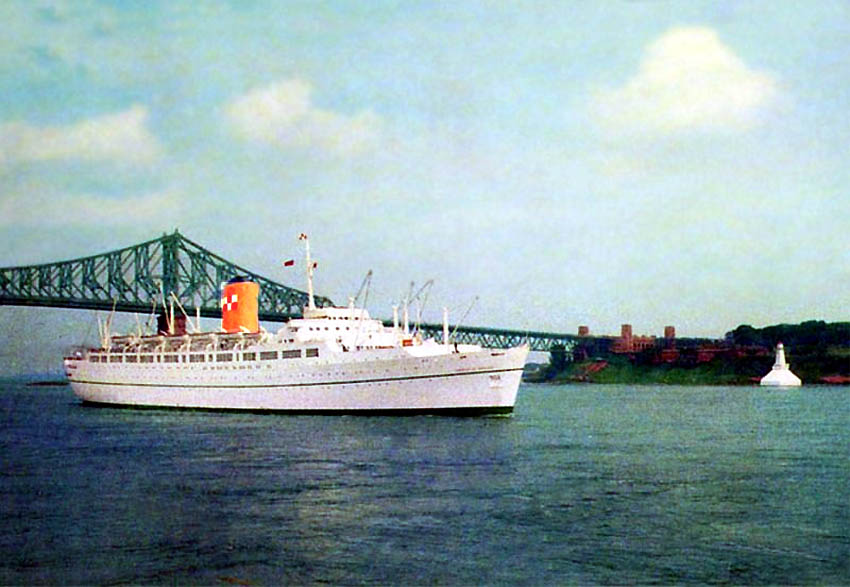
She is back in
The years ahead were filled with union
problems, as well as a collision! On November 8,
1965 the Empress of England collided with the 12,000-ton Norwegian tanker
Lifjord in the St Lawrence at the height of a wild blizzard. The Empress's bow was holed and her stern damaged, resulting in
five days of temporary repairs which was carried out at

This reveals the
damage done to her bow!
This time Canadian Pacific decided this was the time to change their company’s image, and late in 1968 the Canadian Pacific fleet was treated to a “new corporate image.” The famous buff funnel with the much loved red and white chequered house flag disappeared to make way for a new funnel design that was made up of a green and white funnel with what the company described as a logo being to mean: “A triangle to represent motion, a circle for global operations, and a square for stability!” The slender ribbon on the hull was repainted and was now a much wider green band. Generally the public and all ship lovers wrote quite a few strongly written and even a few nasty letters to the company in regard to what was considered as being a hideous approach to their customers and defacing their ships. Thus, the change of the ships livery was met with a massive disapproval and everyone desired to let CP know their feelings!
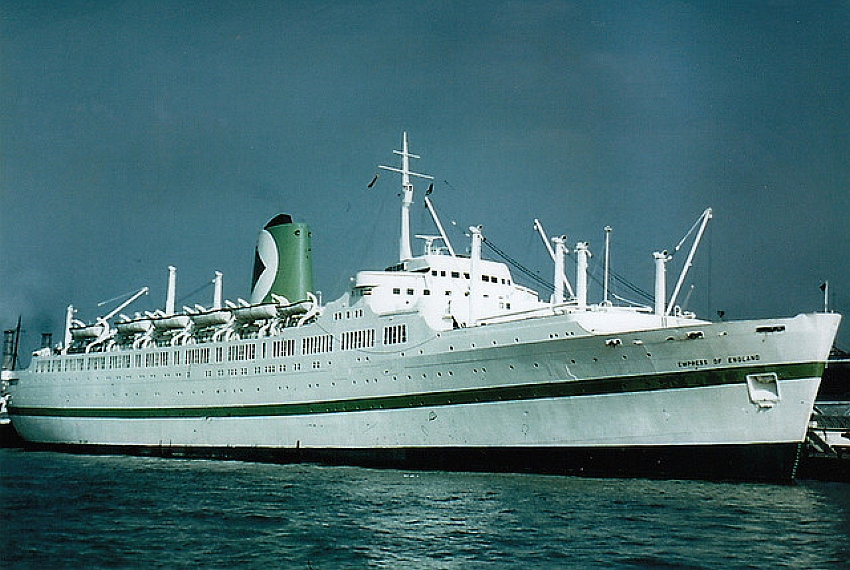
The White
“Empress” is seen in her new livery
With the departure of her slightly older sister, the RMS Empress of Britain, in 1969 there was no doubt that the RMS Empress of England was the mainstay of the St Lawrence service and she completed fourteen round voyages, but sadly loadings (passenger numbers) were rapidly falling! But, CP continued on as long as they could.

The Empress of
England is seen at sea in 1969
She left Liverpool on what was to prove her
final crossing to
In 1969 the Empress of England was the
mainstay of the St Lawrence service and she completed fourteen round voyages.
Then she departed on her scheduled winter crossing on November 14, 1969, but as
Trans Atlantic passenger numbers had by now simply disappeared and the skies
had taken the majority of passengers away from these slow speed liners of
yesteryear, this would be her very last return voyage to
The ship was immediately sold to Shaw Savill
for £5 million. Chairman Robert Russell said “When the Empress of
RMS Empress of
Built: Vickers-Armstrongs,
Yard: 155.
Launched: May 9, 1956.
Maiden Voyage: April 18, 1957.
Tonnage: 25,585 GRT (Gross Registered Tons).
“ 13,725 Net
“ 8,910 D.W. (Dead weight).
Length: 640ft – 195m.
Beam: 85.3
ft – 25.9m
Draught: 29ft
– 8.83m.
Engines: Sic Steam D.R. Steam Turbines from the builder.
Screws: Twin 30,000 SHP.
Speed: 20 knots service speed, max speed 21 knots.
Passengers: 1,058 - 160 First Class & 898 Tourist Class.
Decks: Six passenger decks, plus two top decks for crew only.
Crew: 464.
Air: Fully Air-Conditioned.
Stabilisers: Denny-Brown stabilisers.
***********************************
INDEX:
Page
One: RMS Empress of
Page
Two: SS Ocean Monarch -
History & Photo’s.
Page
Three: SS Ocean Monarch - Photo
Page.
Page
Four: SS Ocean Monarch - Deck
Plan.
***********************************
Who is the
Author of ssMaritime?
Commenced in the passenger Shipping Industry in May
1960
ssMaritime.com & ssMaritime.net
Where the ships of the past make history & the 1914 built MV Doulos
Story
Also visit my
…
“Save The Classic Liners Campaign” page
Photographs on ssmaritime and associate pages are by the author or
from the author’s private collection. In addition there are some
images that have been provided by Shipping Companies and private photographers
or collectors. Credit is given to all contributors. However, there are some
photographs provided to me without details regarding the photographer/owner
concerned. I hereby invite if owners of these images would be so kind to make
them-selves known to me in order that due credit may be given. I know what it
is like, I have seen a multitude of my own photographs on other sites, yet
these individuals either refuse to provide credit or remove them when asked, knowing
full well that there is no legal comeback when it comes to the net. However,
let us show these charlatans up and do the right thing at all times and give
credit where credit is due!
This notice
covers all pages, although, and I have done my best to ensure that all
photographs are duly credited and that this notice is displaced on each page,
that is, when a page is updated!
ssMaritime is owned and © Copyright by Reuben Goossens -
All Rights Reserved
